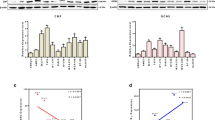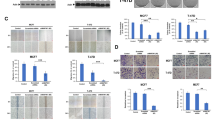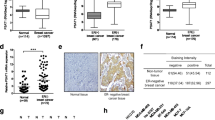Abstract
Purpose In our microarray analysis we observed that Seven-in-Absentia Homolog 2 (SIAH2) levels were low in estrogen receptor (ER) positive breast tumors of patients resistant to first-line tamoxifen therapy. The aim of this study was to evaluate SIAH2 for its (a) predictive/prognostic value, and (b) functional role in endocrine therapy resistance. Patients and methods SIAH2 expression was measured with quantitative Real-Time-PCR (qRT-PCR) in 1205 primary breast tumor specimens and related to disease outcome. The functional role of SIAH2 was determined in human breast cancer cell lines ZR-75-1, ZR/HERc, and MCF7. Cell lines were treated with estrogen (E2), anti-estrogen ICI164.384 or epidermal growth factor (EGF). Moreover, MCF7 was treated with ICI164.384 after silencing SIAH2 expression. Results SIAH2 was not prognostic in 603 lymph node negative patients who had not received adjuvant systemic therapy. In multivariate analysis of ER-positive tumors of 235 patients with recurrent disease, SIAH2 as continuous variable, significantly predicted first-line tamoxifen treatment failure (OR = 1.48; P = 0.05) and progression-free survival (PFS) (HR = 0.79; P = 0.007). Furthermore, in primary breast cancer patients treated with adjuvant tamoxifen, SIAH2 predicted metastasis-free survival (MFS) (HR = 0.73; P = 0.005). In vitro experiments showed that SIAH2 silencing in MCF7 cells resulted in resistance to ICI164.384-treatment when compared with mock silenced cells (P = 0.008). Interestingly, in ZR cells transfected with EGFR (ZR/HERc), SIAH2 expression was induced by E2 but downregulated by EGF. Conclusion In primary breast tumor specimens as well as in vitro low SIAH2 levels associated with resistance to endocrine therapy. Moreover, SIAH2 expression showed an opposite regulation by E2 and EGF.




Similar content being viewed by others
References
Chung YL, Sheu ML, Yang SC et al (2002) Resistance to tamoxifen-induced apoptosis is associated with direct interaction between Her2/neu and cell membrane estrogen receptor in breast cancer. Int J Cancer 97:306–312. doi:10.1002/ijc.1614
Jansen MP, Foekens JA, van Staveren IL et al (2005) Molecular classification of tamoxifen-resistant breast carcinomas by gene expression profiling. J Clin Oncol 23:732–740. doi:10.1200/JCO.2005.05.145
Perou CM, Sorlie T, Eisen MB et al (2000) Molecular portraits of human breast tumours. Nature 406:747–752. doi:10.1038/35021093
van‘t Veer LJ, Dai H, van de Vijver MJ et al (2002) Gene expression profiling predicts clinical outcome of breast cancer. Nature 415:530–536. doi:10.1038/415530a
Roh MS, Hong SH, Jeong JS et al (2004) Gene expression profiling of breast cancers with emphasis of beta-catenin regulation. J Korean Med Sci 19:275–282
Kulakosky PC, McCarty MA, Jernigan SC et al (2002) Response element sequence modulates estrogen receptor alpha and beta affinity and activity. J Mol Endocrinol 29:137–152. doi:10.1677/jme.0.0290137
Holloway AJ, Della NG, Fletcher CF et al (1997) Chromosomal mapping of five highly conserved murine homologues of the Drosophila RING finger gene seven-in-absentia. Genomics 41:160–168. doi:10.1006/geno.1997.4642
Hu G, Chung YL, Glover T et al (1997) Characterization of human homologs of the Drosophila seven in absentia (sina) gene. Genomics 46:103–111. doi:10.1006/geno.1997.4997
Frasor J, Danes JM, Funk CC, Katzenellenbogen BS (2005) Estrogen down-regulation of the corepressor N-CoR: mechanism and implications for estrogen derepression of N-CoR-regulated genes. Proc Natl Acad Sci USA 102:13153–13157. doi:10.1073/pnas.0502782102
Perissi V, Aggarwal A, Glass CK et al (2004) A corepressor/coactivator exchange complex required for transcriptional activation by nuclear receptors and other regulated transcription factors. Cell 116:511–526. doi:10.1016/S0092-8674(04)00133-3
Keeton EK, Brown M (2005) Cell cycle progression stimulated by tamoxifen-bound estrogen receptor-alpha and promoter-specific effects in breast cancer cells deficient in N-CoR and SMRT. Mol Endocrinol 19:1543–1554. doi:10.1210/me.2004-0395
Shou J, Massarweh S, Osborne CK et al (2004) Mechanisms of tamoxifen resistance: increased estrogen receptor-HER2/neu cross-talk in ER/HER2-positive breast cancer. J Natl Cancer Inst 96:926–935
Wang LH, Yang XY, Zhang X et al (2006) Disruption of estrogen receptor DNA-binding domain and related intramolecular communication restores tamoxifen sensitivity in resistant breast cancer. Cancer Cell 10:487–499. doi:10.1016/j.ccr.2006.09.015
Jansen MP, Sieuwerts AM, Look MP et al (2007) HOXB13-to-IL17BR expression ratio is related with tumor aggressiveness and response to tamoxifen of recurrent breast cancer: a retrospective study. J Clin Oncol 25:662–668. doi:10.1200/JCO.2006.07.3676
McShane LM, Altman DG, Sauerbrei W et al (2006) REporting recommendations for tumor MARKer prognostic studies (REMARK). Breast Cancer Res Treat 100:229–235. doi:10.1007/s10549-006-9242-8
Sieuwerts AM, Meijer-van Gelder ME, Timmermans M et al (2005) How ADAM-9 and ADAM-11 differentially from estrogen receptor predict response to tamoxifen treatment in patients with recurrent breast cancer: a retrospective study. Clin Cancer Res 11:7311–7321. doi:10.1158/1078-0432.CCR-05-0560
Dorssers LC, van Agthoven T, Brinkman A et al (2005) Breast cancer oestrogen independence mediated by BCAR1 or BCAR3 genes is transmitted through mechanisms distinct from the oestrogen receptor signalling pathway or the epidermal growth factor receptor signalling pathway. Breast Cancer Res 7:R82–R92. doi:10.1186/bcr954
Foekens JA, Peters HA, Grebenchtchikov N et al (2001) High tumor levels of vascular endothelial growth factor predict poor response to systemic therapy in advanced breast cancer. Cancer Res 61:5407–5414
Foekens JA, Schmitt M, van Putten WL et al (1994) Plasminogen activator inhibitor-1 and prognosis in primary breast cancer. J Clin Oncol 12:1648–1658
Creighton CJ, Hilger AM, Murthy S et al (2006) Activation of mitogen-activated protein kinase in estrogen receptor alpha-positive breast cancer cells in vitro induces an in vivo molecular phenotype of estrogen receptor alpha-negative human breast tumors. Cancer Res 66:3903–3911. doi:10.1158/0008-5472.CAN-05-4363
Frasor J, Stossi F, Danes JM et al (2004) Selective estrogen receptor modulators: discrimination of agonistic versus antagonistic activities by gene expression profiling in breast cancer cells. Cancer Res 64:1522–1533. doi:10.1158/0008-5472.CAN-03-3326
Massarweh S, Osborne CK, Creighton CJ et al (2008) Tamoxifen resistance in breast tumors is driven by growth factor receptor signaling with repression of classic estrogen receptor genomic function. Cancer Res 68:826–833. doi:10.1158/0008-5472.CAN-07-2707
Dowsett M, Nicholson RI, Pietras RJ (2005) Biological characteristics of the pure antiestrogen fulvestrant: overcoming endocrine resistance. Breast Cancer Res Treat 93:S11–S18. doi:10.1007/s10549-005-9037-3
Schiff R, Massarweh SA, Shou J et al (2004) Cross-talk between estrogen receptor and growth factor pathways as a molecular target for overcoming endocrine resistance. Clin Cancer Res 10:331S–336S. doi:10.1158/1078-0432.CCR-031212
Guix M, Granja Nde M, Meszoely I et al (2008) Short preoperative treatment with erlotinib inhibits tumor cell proliferation in hormone receptor-positive breast cancers. J Clin Oncol 26:897–906. doi:10.1200/JCO.2007.13.5939
Acknowledgements
This study was supported by Grant DDHK 2364 of the Dutch Cancer Society, Amsterdam, the Netherlands, and in part by The Netherlands Genomics Initiative/Netherlands Organization for Scientific Research (NWO) the Susan G. Komen Breast Cancer Foundation Grant number BCTR127606, TI Pharma (project number T3-108-1, granted to MPHM J and EMJJ B) and in part by an Erasmus MC grant. We especially thank Miranda Arnold, Anneke Goedheer, Henk Portengen, Roberto Rodriguez Garcia, Mieke Timmermans, Anita Trapman, and Vanja de Weerd for their technical support.
Author information
Authors and Affiliations
Corresponding author
Rights and permissions
About this article
Cite this article
Jansen, M.P.H.M., Ruigrok-Ritstier, K., Dorssers, L.C.J. et al. Downregulation of SIAH2, an ubiquitin E3 ligase, is associated with resistance to endocrine therapy in breast cancer. Breast Cancer Res Treat 116, 263–271 (2009). https://doi.org/10.1007/s10549-008-0125-z
Received:
Accepted:
Published:
Issue Date:
DOI: https://doi.org/10.1007/s10549-008-0125-z




